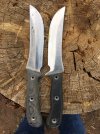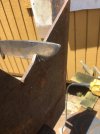-
The BladeForums.com 2024 Traditional Knife is ready to order! See this thread for details: https://www.bladeforums.com/threads/bladeforums-2024-traditional-knife.2003187/
Price is$300$250 ea (shipped within CONUS). If you live outside the US, I will contact you after your order for extra shipping charges.
Order here: https://www.bladeforums.com/help/2024-traditional/ - Order as many as you like, we have plenty.
You are using an out of date browser. It may not display this or other websites correctly.
You should upgrade or use an alternative browser.
You should upgrade or use an alternative browser.
Z-TUFF
- Thread starter rodriguez7
- Start date
Willie71
Warren J. Krywko
- Joined
- Feb 23, 2013
- Messages
- 12,214
I did some coupons for our charpy testing. Here’s the results:
Z-tuff hardness was:
1900fx40min, cryo 1h, 400f temper, 2hx3. Rc58-60.
1975fx30min, cryo 1h, 400f temper, 2hx3. Rc60-63 (most readings were Rc61/62, but not all were consistent.)
2050fx20min, cryo 1h, 400f temper, 2hx3, Rc58-64.
Z-tuff hardness was:
1900fx40min, cryo 1h, 400f temper, 2hx3. Rc58-60.
1975fx30min, cryo 1h, 400f temper, 2hx3. Rc60-63 (most readings were Rc61/62, but not all were consistent.)
2050fx20min, cryo 1h, 400f temper, 2hx3, Rc58-64.
rodriguez7
Gila wilderness knife works
- Joined
- Feb 1, 2009
- Messages
- 1,428
I’m curious to see if there will be a toughness increase with the lower aus temp! Thanks for this! I haven’t tried anything else but a 1925 aus temp. No time for testing sadly.I did some coupons for our charpy testing. Here’s the results:
Z-tuff hardness was:
1900fx40min, cryo 1h, 400f temper, 2hx3. Rc58-60.
1975fx30min, cryo 1h, 400f temper, 2hx3. Rc60-63 (most readings were Rc61/62, but not all were consistent.)
2050fx20min, cryo 1h, 400f temper, 2hx3, Rc58-64.
Willie71
Warren J. Krywko
- Joined
- Feb 23, 2013
- Messages
- 12,214
I’m curious to see if there will be a toughness increase with the lower aus temp! Thanks for this! I haven’t tried anything else but a 1925 aus temp. No time for testing sadly.
I’m really looking forward to seeing the toughness of this steel. This, and Rex121, and V4e. I’m thinking there is going to be room for optimizing z-tuff, a process that balances toughness and edge holding.
rodriguez7
Gila wilderness knife works
- Joined
- Feb 1, 2009
- Messages
- 1,428
I wonder what kind of toughness could be gained with a marquench. Have you tried this on any of your samples? Or do you not have a way to do it? This was recommended to me by a European maker, with mod A8.I did some coupons for our charpy testing. Here’s the results:
Z-tuff hardness was:
1900fx40min, cryo 1h, 400f temper, 2hx3. Rc58-60.
1975fx30min, cryo 1h, 400f temper, 2hx3. Rc60-63 (most readings were Rc61/62, but not all were consistent.)
2050fx20min, cryo 1h, 400f temper, 2hx3, Rc58-64.
Willie71
Warren J. Krywko
- Joined
- Feb 23, 2013
- Messages
- 12,214
I wonder what kind of toughness could be gained with a marquench. Have you tried this on any of your samples? Or do you not have a way to do it? This was recommended to me by a European maker, with mod A8.
I’m not set up for marquench at this time.
rodriguez7
Gila wilderness knife works
- Joined
- Feb 1, 2009
- Messages
- 1,428
Sadly! I would like to see if there are any gains! Some people claim great results.I’m not set up for marquench at this time.
rodriguez7
Gila wilderness knife works
- Joined
- Feb 1, 2009
- Messages
- 1,428
So, I’ve been doing a little testing with different heat treats with the limited time I have. I made 2 identical blades with 2 different heat treats. 6 inch Bowie style hunters. One austenized @1900, triple tempered at 400, the other austenized @1875, triple tempered at 1000. This is not destruction testing, that was saved for another junk knife with 1000 degree tempers done too.
From what I’ve been able to gather so far, if your looking for indestructible, it seems that your best bet is the 1000 degree temper! I have not been able to break my other test knife with this heat treat. It has cut 1/4 inch plate, hammered through bone, and cinder blocks, used for throwing and prying and still refuses to break. It’s been nothing but amazing, as far as gross toughness!
But as far as edge durability, and edge stability, that goes to the low temper. This steel behaves similar to 3v as far as the low temper heat treat. Which is the heat treat I’ll be using for my hunters and skinners! It also has amazing corrosion resistance also. This steel is my favorite so far! It’s rather amazing. I still have some further testing to do in the future. But it’ll be months from now! I’ll try and post pics of the edges after chopping through an elk antler, and the 1/4 inch plate testing.
From what I’ve been able to gather so far, if your looking for indestructible, it seems that your best bet is the 1000 degree temper! I have not been able to break my other test knife with this heat treat. It has cut 1/4 inch plate, hammered through bone, and cinder blocks, used for throwing and prying and still refuses to break. It’s been nothing but amazing, as far as gross toughness!
But as far as edge durability, and edge stability, that goes to the low temper. This steel behaves similar to 3v as far as the low temper heat treat. Which is the heat treat I’ll be using for my hunters and skinners! It also has amazing corrosion resistance also. This steel is my favorite so far! It’s rather amazing. I still have some further testing to do in the future. But it’ll be months from now! I’ll try and post pics of the edges after chopping through an elk antler, and the 1/4 inch plate testing.
rodriguez7
Gila wilderness knife works
- Joined
- Feb 1, 2009
- Messages
- 1,428
rodriguez7
Gila wilderness knife works
- Joined
- Feb 1, 2009
- Messages
- 1,428
rodriguez7
Gila wilderness knife works
- Joined
- Feb 1, 2009
- Messages
- 1,428
I ended up with 57-59 rc with that heat treat. The other one was right at 60 consistently.1875-1000 would likely lead to much lower hardness than 1900-400, which may explain the observed differences.
rodriguez7
Gila wilderness knife works
- Joined
- Feb 1, 2009
- Messages
- 1,428
I can’t upload the other pics for some reason.
rodriguez7
Gila wilderness knife works
- Joined
- Feb 1, 2009
- Messages
- 1,428
I’ll be trying 1875/400 on my next blade. Should end up around 58rc.
rodriguez7
Gila wilderness knife works
- Joined
- Feb 1, 2009
- Messages
- 1,428
I should have clarified, the other test knife was austenized at 1925, cryo, and triple tempered at 1000. I’ve still yet to break it, and I’ve beat the hell out of it. It’s held up to more abuse then 8670, with a spring tempered spine.1875-1000 would likely lead to much lower hardness than 1900-400, which may explain the observed differences.
I should have clarified, the other test knife was austenized at 1925, cryo, and triple tempered at 1000. I’ve still yet to break it, and I’ve beat the hell out of it. It’s held up to more abuse then 8670, with a spring tempered spine.
Have you try higher austenitizing temp like 1950 or 1975? I believe higher aus temp will lead to more carbon in solution (more martensite and RA) so more carbide precipitate with 1000F tempering.
rodriguez7
Gila wilderness knife works
- Joined
- Feb 1, 2009
- Messages
- 1,428
No I haven’t. But it would be interesting to try it. I actually never thought of that. The higher tempering definitely gives different results. I just haven’t figured out if the results are better or worse. But I guess it depends on the knife and the use!Have you try higher austenitizing temp like 1950 or 1975? I believe higher aus temp will lead to more carbon in solution (more martensite and RA) so more carbide precipitate with 1000F tempering.
I have been heat treating Ztuff using a 1950 austenitizing for 30 minutes with a plate quench and three 1000 degree tempers, no cryo. The hardness has been coming out at 59-60rc, heavy on the 60rc side. I have not done any destruction test but from use in the field over the last year i have had better edge stability, less micro chipping, than 3v with the same heat treat.
Willie71
Warren J. Krywko
- Joined
- Feb 23, 2013
- Messages
- 12,214
I have been heat treating Ztuff using a 1950 austenitizing for 30 minutes with a plate quench and three 1000 degree tempers, no cryo. The hardness has been coming out at 59-60rc, heavy on the 60rc side. I have not done any destruction test but from use in the field over the last year i have had better edge stability, less micro chipping, than 3v with the same heat treat.
If you did cryo with 350 or 400 temper, you would get the Rc61 or a bit more you are looking for.
If you did cryo with 350 or 400 temper, you would get the Rc61 or a bit more you are looking for.
Thank you. I still have not ventured into cryo as it is an hour and half drive and 15 dollars per liter to obtain. I am not having performance issues not using cryo but I see with some steels if i want higher hardness than it is a route i will have to take.


